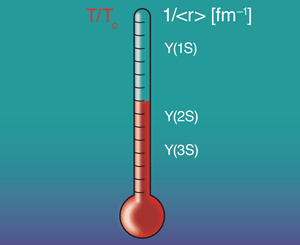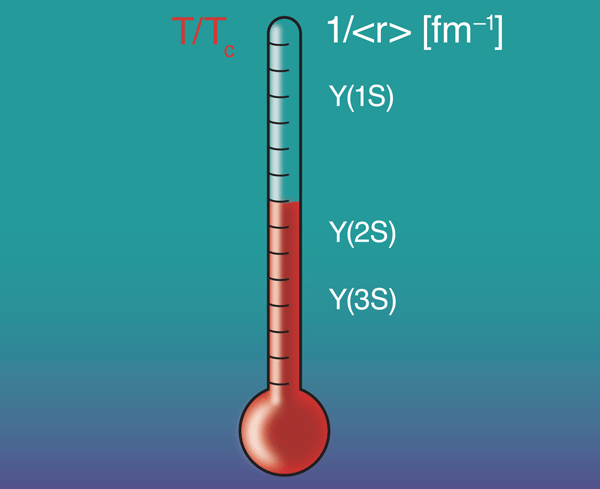New Temperature Probe for Quark-Gluon Plasma
At the Large Hadron Collider (LHC), lead ions are collided at several tera-electron-volts to produce a soup of quarks and gluons called the quark-gluon plasma. Measuring the temperature of the plasma, which only survives for seconds and is hotter than the Sun‘s interior, would be impossible with any normal thermometer. Instead, researchers gauge the plasma’s temperature by measuring its effects on other particles created in the collision. Interpreting these “particle thermometers,” however, has not been entirely straightforward. Now, the collaboration running the CMS experiment at the LHC reports in Physical Review Letters that the detected yields of Upsilon mesons (bound states of a bottom quark and its antiparticle) in the plasma provide a comparatively clean measure of the plasma’s temperature. The CMS researchers have made the first statistically significant detection of the suppression of the first two excited states of the mesons, a suppression that becomes more pronounced at higher plasma temperatures [1].
Upsilon mesons (denoted ) are a kind of quarkonium, a short-lived bound state between a heavy quark and its antiparticle that can be created in high-energy particle collisions. Structurally, quarkonium is similar to the bound state that forms between an electron and a positron (positronium), but in addition to a Coulomb-like potential between the two quarks, , where is a coupling based on one-gluon exchange, there is also a potential, , that is similar to the elastic tension in a rigid string. In the presence of the “deconfined” quarks and gluons that make up the quark-gluon plasma, both of these terms become weaker: the surrounding plasma effectively screens the force between the quarks in the bound state.
In the mid-80s, the theorists Tetsuo Matsui and Helmut Satz predicted that, as a result of this screening effect, the number of quarkonium states detected in a heavy-ion collision would be a lot lower, or “suppressed,” if the collision produced a quark-gluon plasma [2]. Suppression would not imply the absence of produced quarkonium, but rather that the observed yields were depleted relative to the expected yield, either because the quark-antiquark pair failed to form a quarkonium state, or the state itself was destroyed through its subsequent interactions.
So far, researchers have studied two quarkonium “families” in heavy-ion collisions: charmonium, bound states of a charm and anticharm quark, and bottomonium, bound states of a bottom and antibottom quark. (Bottomonium includes the Upsilon mesons.) Since the charm quark is lighter than the bottom quark, and more copiously produced in heavy-ion collisions, early experiments at CERN’s Super Proton Synchrotron focused on charmonium, and more specifically the suppression of its first excited state, known as [3]. But the is an imperfect temperature probe: For one, the lepton pairs produced in decays (which are what experiments actually measure) have insufficient momentum to make it past the high magnetic fields of the CMS particle spectrometer and into the detector. Second, other, non-quark-gluon plasma effects can cause the suppression of .
In contrast, CMS can more cleanly detect the lepton pairs produced by Upsilon decays. Partly, this is because each lepton carries half the Upsilon meson’s mass, giving it enough momentum to shoot through the magnetic fields and into the detector. But another important factor is the CMS detector’s excellent dilepton mass resolution. Prior to the LHC, the separation of the three mass peaks associated with the lowest-energy Upsilon state ( ) and its first two excited states ( and ) had only been observed in proton-antiproton collisions at the Tevatron. The CMS experiment is the first to cleanly separate these peaks in heavy ion collisions – a unique accomplishment. The clear separation of the peaks that CMS observes makes it much easier to interpret Upsilon suppression and how it relates to the plasma’s temperature [4].
The main sensitivity to temperature comes from comparing the suppressions of the different Upsilon states: The more highly excited states are progressively less tightly bound and have a larger effective radius than the ground state, and are therefore more sensitive to the plasma’s temperature. For each state, the screening length – a measure of the distance beyond which a quark’s color charge is screened – decreases with increasing temperature and can be calculated with lattice quantum chromodynamics [5]. When the temperature is high enough that the screening length is the same as the radius of a given Upsilon state, the state will no longer remain bound in the medium, and its final-state yield will be reduced. Thus Upsilon states with larger radii and smaller binding energies will break up first, while those with smaller radii and larger binding energies require higher temperatures to be suppressed (Fig. 1). The suppression of the state first, then , and then is called sequential suppression [6], and the LHC is the first machine at which it is possible to see it for bottomonium states.
Experimentally, CMS determines the amount of suppression of the individual states in the lead-lead collisions by comparing them to yields from proton-proton collisions of the same energy. The suppression levels also depend on the centrality of the collisions: head-on collisions involve most of the nucleons in both nuclei and make a hotter quark-guon plasma, while more peripheral collisions involve fewer nucleons and yield a smaller, cooler plasma. All of this is contained in a number called the suppression factor, , which is the ratio of a particular state in the lead-lead collision relative to that in proton-proton collisions, normalized to account for the centrality of the collision.
In terms of actual numbers, CMS finds that , with its low binding energy, is completely suppressed by the medium ( ). The is also highly suppressed: is less than in peripheral collisions and less than in more central collisions. CMS sees the suppression of , too, but this is not because the quark-gluon plasma suppresses production (the temperature is not high enough to see a direct suppression of the most tightly bound state), but because the excited states are suppressed and don’t feed down. The and are suppressed relative to the with a greater than five standard deviation significance, the gold standard for discovery physics.
Some work remains to be done, however. There are non-quark-gluon plasma, or “cold matter” effects that may be affecting the apparent sequential suppression. These effects can be studied in the forthcoming proton-lead collision run at the LHC. Since the proton-proton baseline is the limiting factor in CMS’s current statistical analysis, another proton-proton run at tera-electron-volts (the same energy as the heavy-ion collisions) should further reduce the uncertainties. Finally, future lead-lead collision data with better statistics should reveal the ratios as a function of transverse momentum [7]. Ultimately, these refinements would allow researchers to use Upsilon suppression as a way to more fully characterize the quark-gluon plasma.
Acknowledgment
This work was performed under the auspices of the U.S. Department of Energy by Lawrence Livermore National Laboratory under Contract DE-AC52-07NA27344.
References
- S. Chatrchyan et al. (CMS Collaboration), “Observation of Sequential Y Suppression in PbPb Collisions,” Phys. Rev. Lett. 109, 222301 (2012)
- T. Matsui and H. Satz, ” Suppression by Quark-Gluon Plasma Formation,” Phys. Lett. B 178, 416 (1986)
- L. Kluberg, 20 years of suppression at the CERN SPS, Results from Experiments NA38, NA51 and NA50,” Eur. Phys. J. C 43, 145 (2005); L. Kluberg and H. Satz, “Color Deconfinement and Charmonium Production in Nuclear Collisions,” arXiv:0901.3831 (hep-ph)
- A. D. Frawley, T. Ullrich, and R. Vogt, “Heavy Flavor in Heavy-Ion Collisions at RHIC and RHIC II,” Phys. Rep. 462, 125 (2008)
- H. Satz, “Colour Deconfinement and Quarkonium Binding ,” J. Phys. G 32, R25 (2006)
- S. Digal, P. Petreczky, and H. Satz, “Quarkonium Feed-Down and Sequential Suppression,” Phys. Rev. D 64, 094015 (2001)
- J. F. Gunion and R. Vogt, Determining the Existence and Nature of the Quark-Qluon Plasma by Upsilon Suppression at the LHC,” Nucl. Phys. B 492, 301 (1997)





